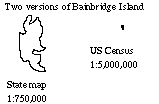Generalization and Scale-changing
Basic conversion: rich, detailed data sources selectively represented
(re - presented...) for different purposes at more and more generalized
scale.
Generalization is a general process of limiting the information
on a map.
Connections to previous lectures:
The physical limits of the graphic medium used
to control the process,
the computer makes it more self-conscious.

Components of Generalization
(as given by RSMM)
As with Graphic Design: Elements (tools) and Controls (constraints)
ELEMENTS of generalization
CONTROLS of generalization
Another framework for generalization (Kate Beard 1990)
Procedures for Scale-Changing (after Kate Beard PhD)
SELECT (reduce number of objects)
AGGREGATE
REDUCE (simplify geometry)

COLLAPSE (reduce number of objects and simplify geometry)
COARSEN (reduce number of objects and simplify geometry)
McMaster and Shea
- Why we generalize (Objectives)
Some links to generalization issues:
The Douglas algorithm from the horse's
mouth
International Cartographic Asociation Working
Group on Generalization
University of Zurich
research group
(some of their current projects)
QTM Comix
(G. Dutton) (more
QTM)
AGENT site (Institut Geographique
Nationale - France)
Version of 16 May 2001

